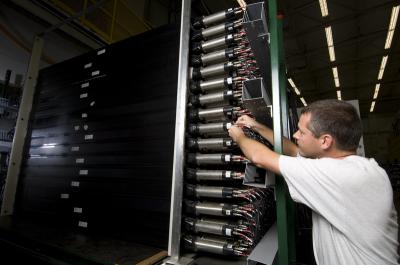|
Related Topics: |
|
|
|
Current News |
|
Chemistry A to Z |
|
About Internetchemistry |
Nuclear physicists examine oxygen's limits |
|
The finding, published in Physical Review Letters, confirms a relatively new theoretical model that predicts dramatic changes in structure as one looks at heavier and heavier oxygen nuclei. In the experiment, researchers measured a never-before-seen energy state of oxygen 23 - one of the heaviest oxygen isotopes that exist. "It was very exciting to see an experiment that was able to observe this [energy] state very close to where we predicted," said Alex Brown, a professor a NSCL who was involved in the shaping of the theory. |
|
Atomic nuclei are composed of protons and neutrons, only certain combinations of which can exist. Each element - determined by the number of protons in its nucleus - comes in a variety of flavors with different numbers of neutrons, creating isotopes. The search for the maximum number of neutrons that can fit into a given element's nucleus lies at the forefront of nuclear physics research. Moving towards the limit of nuclear stability often leads to strange behavior, such as unexpected changes in nuclear structure. "We thought we understood the nuclear forces well," said Andreas Schiller, an assistant professor at Ohio University and lead researcher on the study. "But it turns out, when we go to extreme ratios of neutrons and protons, the forces in those areas still hold surprises." While oxygen 23 contains 8 protons and 15 neutrons, stable form of oxygen, making up the bulk of the oxygen found on Earth, has only 8 neutrons. A few years ago, scientists tweaked an older version of the theory of atomic nuclei to try to explain some startling phenomena among the heavier oxygen isotopes. The new calculations predicted more dramatic changes in structure among the heavier oxygen isotopes. The experiment, which was conducted at NSCL, confirms these predictions. Looking at the excited states of a nucleus - reached by adding extra energy into it - is a good way to understand the forces inside it, said Michael Thoennessen, associate director of nuclear science at NSCL and co-author of the paper. The result paves the road to studying the neighboring oxygen 24 - the heaviest possible oxygen isotope. Many more mysteries remain to be explored, physicists say. As many as 8,000 nuclei are predicted to exist, but so far only 2,000 have been observed. The experiment, funded by the National Science Foundation, was the first to yield new information from two tailored NSCL tools, which came on line only recently. One device, the Modular Neutron Array, detects neutrons with high efficiency, and the other, the sweeper magnet, uses NSCL's superconducting magnet technology to allow a higher percentage of sought-after particles to pass. These devices make it possible to explore isotopes farther towards the extreme edges of existence, by making experimental run times up to seven times shorter. "Without them you couldn't do the experiments," Thoennessen said. |
|
|
|


